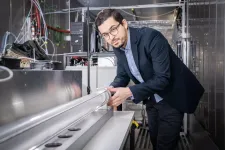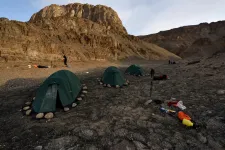Zooming in on muscle cells
Max Planck Institute's researchers use electron cryo-tomography to reveal novel molecular details of skeletal sarcomeres
2021-03-24
(Press-News.org) An old technique flexes its muscles
Sarcomeres are small repeating subunits of myofibrils, the long cylinders that bundle together to make the muscle fibres. Inside the sarcomeres, filaments of the proteins myosin and actin interact to generate muscle contraction and relaxation. So far, traditional experimental approaches to investigate the structure and function of muscle tissue were performed on reconstructed protein complexes or suffered from low resolution. "Electron cryo-tomography, instead, allows us to obtain detailed and artefact-free 3D images of the frozen muscle", says Raunser.
Cryo-ET was for a long time an established yet niche methodology. But recent technical advances in electron cryo-microscopy (cryo-EM) as well as the new development of cryo focused ion beam (FIB) milling are pushing cryo-ET resolution. Similar to cryo-EM, researchers flash-freeze the biological sample at a very low temperature (- 175 °C). Through this process, the sample preserves its hydration and fine structure and remains close to its native state. FIB milling is then applied to shave away extra material and obtain an ideal thickness of around 100 nanometers for the transmission electron microscope, which acquires multiple images as the sample is tilted along an axis. Finally, computational methods reconstruct a three-dimensional picture at high resolution.
Raunser's team performed cryo-ET on mouse myofibrils isolated at the King's College, and obtained a resolution of one nanometer (a millionth of a millimetre, enough to see fine structures within a protein): "We can now look at a myofibril with details thought unimaginable only four years ago. It's fascinating!", says Raunser.
Fibres in their natural context
The calculated reconstruction of the myofibrils revealed the three-dimensional organisation of the sarcomere, including the sub regions M-, A-, and I- bands, and the Z-disc, which unexpectedly forms a more irregular mesh and adopts different conformations. The scientists used a sample with myosin strongly bound to actin, representing a stage of the contracting muscle that is called the rigor state. And indeed, they could visualise for the first time in the native cell how two heads of the same myosin bind to an actin filament. They also discovered that the double head not only interacts with the same actin filament but is also found split between two actin filaments. This has never been seen before and shows that proximity to the next actin filament is stronger than the cooperative effect between the neighbouring heads.
"This is just the beginning. Cryo-ET is moving from niche to widespread technology in structural biology", says Raunser. "Soon we will be able to investigate muscle diseases at molecular and even atomic level". Mouse muscles are very similar to those of humans, yet scientists plan to investigate muscle tissue from biopsies or derived from pluripotent stem cells.
INFORMATION:
ELSE PRESS RELEASES FROM THIS DATE:
2021-03-24
In the heart of black cherry's native range, including a part of the Allegheny Hardwoods that bills itself as the "Black Cherry Capital of the World," the tree's regeneration, growth and survival have all been declining for more than a decade. In a new analysis, a team of USDA Forest Service and University of Missouri scientists identify likely factors behind the tree's decline and, more significantly, conclude that black cherry may be the tip of the iceberg in terms of change in eastern deciduous forests.
Scientists used a combination of synthesis of existing research and new analyses to examine the leading hypotheses for black cherry's regeneration failure. They conclude that the two factors that are ...
2021-03-24
Family-centered prevention programs that foster protective caregiving can buffer the negative effects of racial discrimination on young Black people, according to a study published by University of Georgia researchers.
Research shows that Black youth exposed to various levels of racial discrimination--including slurs, threats and false accusations--are at a high risk for poor mental health outcomes such as hopelessness, conduct problems, drug use and depression. After participating in family-oriented programs, high school-age adolescents who encountered high levels of racial discrimination and received supportive caregiving evinced fewer increases in conduct problems and depression/anxiety symptoms two years later.
"This research shows that ...
2021-03-24
The high temperatures and pressures of the Earth's mantle forge carbon-rich minerals known as carbonates into diamond. But less is known about the fate of carbonates that travel even deeper underground -- depths from which no sample has ever been recovered.
Now, Michigan State University's Susannah Dorfman and her team are unearthing an answer with lab tools that mimic these extreme conditions.
"What we were interested in is, when is carbon not diamond?" added Dorfman.
In a paper recently published in Nature Communications, scientists in Dorfman's Experimental ...
2021-03-24
Researchers at the Paul Scherrer Institute PSI have studied for the first time how chemical reactions in clouds can influence the global climate. They found that isoprene, the dominant non-methane organic compound emitted into the atmosphere, can strongly contribute to the formation of organic aerosols in clouds. They published their results today in the journal Science Advances.
Aerosols, a mixture of solid or liquid particles suspended in the air, play an important role in Earth's climate. Aerosols originate either from natural or human sources. They influence Earth's radiation balance by interacting with sunlight and forming clouds. However, their effect remains the single most significant uncertainty ...
2021-03-24
CHICAGO -- Immunotherapy, which recruits the body's own immune system to attack cancer, has given many cancer patients a new avenue to treat the disease.
But many cancer immunotherapy treatments can be expensive, have devastating side effects, and only work in a fraction of patients.
Researchers at the Pritzker School of Molecular Engineering at the University of Chicago have developed a new therapeutic vaccine that uses a patient's own tumor cells to train their immune system to find and kill cancer.
The vaccine, which is injected into the skin just like a traditional vaccine, stopped ...
2021-03-24
Addressing uncertainties about where large earthquakes are most likely to occur along the southern San Andreas fault, which splits into multiple strands east of Los Angeles, a new study identifies a strand that has largely flown under the radar of public concern as the region's greatest earthquake threat. The study determines that the Mission Creek strand, which passes through major water and power infrastructure for the greater Los Angeles region, may account for almost the entire slip rate of this portion of the fault, suggesting it may actually be the primary Pacific-North American plate boundary fault at this latitude. The San Andreas fault threatens large future earthquakes, since its southernmost section has not ruptured in almost 300 years ...
2021-03-24
A 12-centimetre-thick sample of a deposit from a cave in the northeast of Greenland offers unique insights into the High Arctic's climate more than 500,000 years ago. The geologist and cave scientist Prof. Gina Moseley collected it during an exploratory expedition in 2015 for her palaeoclimatic research in one of the most sensitive areas of the world to climate change. The cave is located at 80° North 35 km from the coast and 60 km from the Greenland Ice Sheet margin. It was part of the Greenland Caves Project, funded by 59 different sponsors including the National Geographic Society. Moseley and her team are interested in the climate and environmental history captured by the unique cave deposit. "Mineral deposits formed ...
2021-03-24
A study of 49 patients reveals that toxins from the bacterial pathogen Staphylococcus aureus can destroy the body's blood-clotting platelets, raising the risk of death during bacterial blood infections. Further experiments in mice also showed that the approved drugs ticagrelor and oseltamivir protected platelets and helped treat infections, suggesting these compounds could be repurposed into badly needed therapies for blood infections. Bacterial blood infections have mortality rates as high as 20% to 30% even with supportive care, and these rates have remained high for decades. Blood infections can also cause complications such as sepsis and endocarditis, and the rise of multidrug resistance has only compounded what was already a serious ...
2021-03-24
Immunotherapy, which recruits the body's own immune system to attack cancer, has given many cancer patients a new avenue to treat the disease.
But many cancer immunotherapy treatments can be expensive, have devastating side effects, and only work in a fraction of patients.
Researchers at the Pritzker School of Molecular Engineering at the University of Chicago have developed a new therapeutic vaccine that uses a patient's own tumor cells to train their immune system to find and kill cancer.
The vaccine, which is injected into the skin just like a traditional vaccine, stopped melanoma tumor growth in mouse models. It even worked long-term, destroying new tumors long after the therapy was given.
The results were published ...
2021-03-24
Eating just one cup of leafy green vegetables every day could boost muscle function, according to new Edith Cowan University (ECU) research.
The study, published today in the Journal of Nutrition, found that people who consumed a nitrate-rich diet, predominantly from vegetables, had significantly better muscle function of their lower limb.
Poor muscle function is linked to greater risk of falls and fractures and is considered a key indicator of general health and wellbeing.
Researchers examined data from 3,759 Australians taking part in Melbourne's Baker Heart and Diabetes Institute AusDiab study over a 12-year ...
LAST 30 PRESS RELEASES:
[Press-News.org] Zooming in on muscle cells
Max Planck Institute's researchers use electron cryo-tomography to reveal novel molecular details of skeletal sarcomeres



